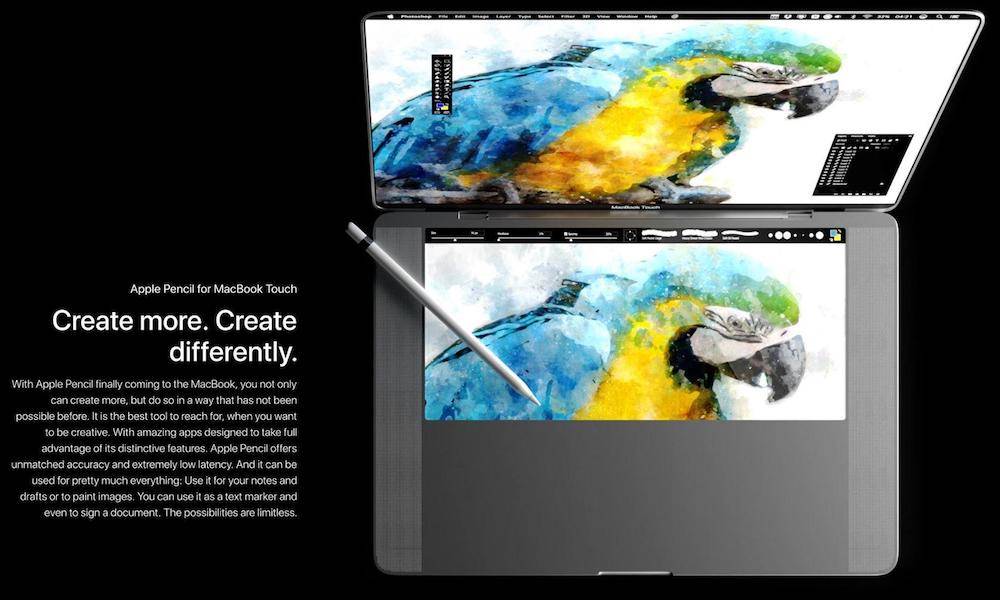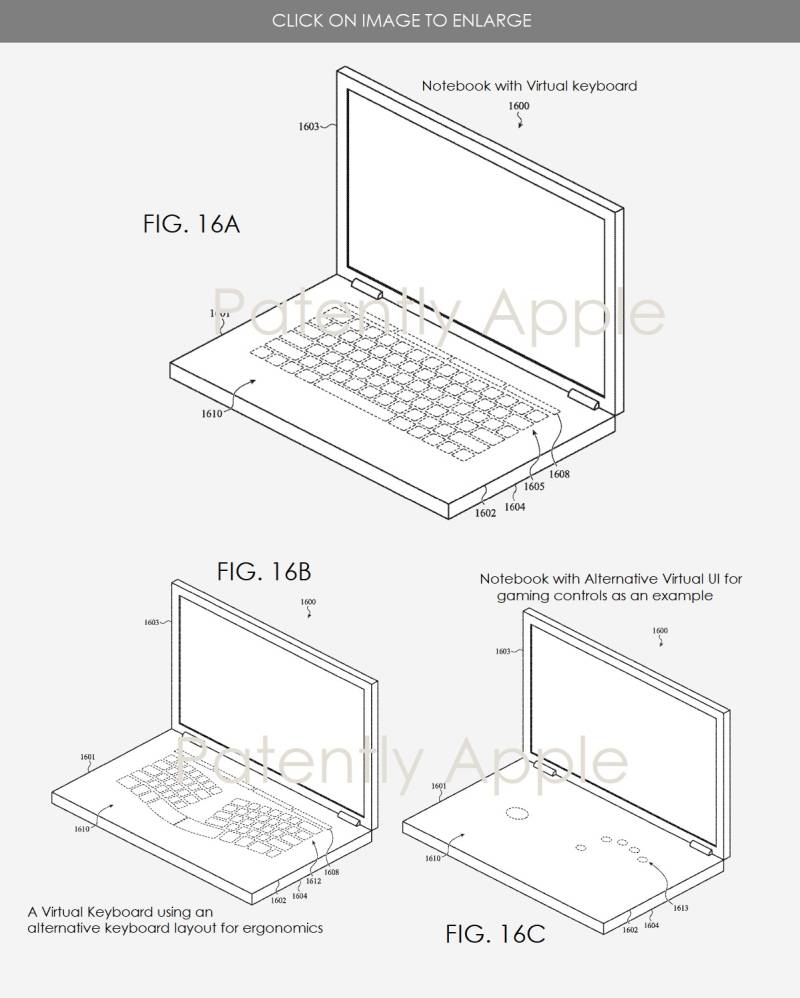Dual-Display MacBook with Morphing Virtual Keyboard May Be in the Works
 Credit: Handy Abovergleich
Credit: Handy Abovergleich
Toggle Dark Mode
With each generation, Apple endeavors to slim down its MacBook computers, not only reducing the thickness of their aluminum shells, but also some of their hardware components like the built-in keyboard along with it. Given the company’s insatiable desire to engineer thinner, lighter and yet more advanced products, it certainly begs the question: how much can Apple legitimately trim off its flagship notebook computers without axing the keyboard, altogether?
Curiously, as the MacBook has been re-designed and re-engineered over the years and new input methods like the OLED Touch Bar have emerged on the scene, Apple has filed for multiple new patents relating to various embodiments of a “dual-display MacBook” design, which does away with the hardware keyboard entirely..
Back in February, Apple was granted its first of such patents covering a MacBook concept where the traditional Island-style chiclet keyboard is replaced by a large and expansive OLED Touchscreen keyboard.
Replacing the MacBook’s Keyboard
On Friday, another new Apple patent application was published by the U.S. Patent & Trademark Office relating to an even more futuristic dual-display MacBook concept, where an advanced interface system would take the place of a traditional keyboard.
The keyboard area is described by Apple as a “morphing virtual interface” allowing the user to deploy and interact with a variety of keyboard and input interfaces — including the form of a virtual game controller — as well as new virtual buttons which aren’t associated with traditional mechanical keyboards.
Patently Apple notes how the virtual keyboard area can be configured to receive a variety of user inputs, including a QWERTY or QWERTZ typing surface, and multi-touch functionality for gesture-based swipes, taps and more.
Apple’s uses several figures to illustrate these methods, including FIGs. 16A, 16B and 16C (below) which depict an overview of the virtual keyboard area and its capabilities.

In patent FIG. 16A, Apple illustrates the virtual keyboard (#1605) in a traditional QWERTY or QWERTZ layout, with the virtual area capable of displaying a variety of different keyboard layouts.
FIG. 16B shows that an ergonomic keyboard layout can be used — while in FIG. 16C we’re shown that the base input area could even be used in other ways, for varying input types, such as one capable of doubling as a game controller with virtual buttons.
“Other keyboard configurations are also possible, such as swapping the position of the virtual keyboard and trackpad so that the keyboard is closer to the front edge and the trackpad at the top,” Patently Apple explained, adding that the company could introduce a “monolithic component” accessory (such as a silicon skin) for placing atop the virtual keyboard area so as to provide the user with Taptic feedback through it.
Implications
Moreover, the virtual keyboard could open up a world of new features and possibilities on MacBook, including an advanced Spell Check feature as outlined in Apple’s patent FIG. 48E.

“When the user applies a touch gesture to the Spacebar (key #4844e), as in sliding a finger or thumb along path (#4846e), it may result in a user accepting a suggested spelling of a misspelled word when typing in a word processing app or other text input field,” Patently Apple explains.
New Dial Input Device
Apple describes another new feature in patent FIG. 49B — a peripheral rotating dial, also referred to as a Peripheral Input Unit, which could attach to the virtual surface area and allow for advanced, precision manipulation of certain inputs.
It’s worth noting that the Peripheral Input Unit presented herein looks a lot like the Microsoft Surface Dial — a cylindrical-shaped peripheral allowing for advanced interaction with Surface computers — although Apple didn’t steal the idea from Microsoft.
Griffin, a high-quality Mac and iPhone accessory-maker, has been selling its eerily-similar looking PowerMate dial for over a year now.
[amazon_link asins=’B07FLSSRPG’ template=’ChromaProductCard’ store=’idropncom0a-20′ marketplace=’US’ link_id=’48a32f5c-9999-11e8-931a-07be99af237c’]
Other Keyboard-less MacBook Features
Finally, Apple’s patent application goes on to describe the aforementioned MacBook concept’s peripheral features, which, according to the literature, could include wireless charging capabilities through an externally-mounted attachment, as well as advanced biometric security which could include finger- and even palm-printing for authentication.
Interestingly, Apple even talks about using these biometric sensors to record a user’s heart rate, blood oxygenation levels, temperature and other vitals, which could also be used for authentication purposes.
Will Apple Ever Release a MacBook Like This?
As we mentioned, Apple has been dabbling in the patent department for years now, coming up with a variety of new MacBook concepts including one that does away with the traditional Force Touch trackpad in favor of a docking station through which an iPhone would be able to connect and interface for advanced system control.
Apple’s patent application (No. 20180217669) was filed back in March, 2018 and published on Friday. Given this is merely a patent application, the likelihood and timing of a product like it to market is unknown. It’s definitely worth pointing out, though, that PC-maker Lenovo already beat Apple to market with a dual-“display” notebook — the Yoga Book, which even allows for stylus input.
Still, Apple’s dual-display MacBook is only a vision right now. But if it ever does come to market one day, we can certainly expect it to be more advanced than anything Lenovo’s got going on.
For more about the technical details of Apple’s dual-display MacBook patent, be sure to visit our friends over on Patently Apple!






